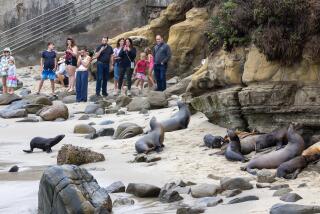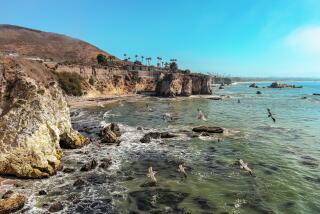Study to Determine Fate of Marina Animal Sanctuary
- Share via
County officials will remove all of the animals from a makeshift bird and animal sanctuary near Marina del Rey if a study links the creatures to persistent high bacteria levels at a nearby beach.
A San Francisco firm was hired last week to conduct a 9-week, $74,000 study to discover the source of the pollution that has kept the marina’s only beach closed since October.
Mothers’ Beach
Officials suspect animal feces in the runoff from the sanctuary may be the source of high fecal coliform bacteria counts in the waters off the beach. The beach, nicknamed Mothers’ Beach, is at the end of Basin D in the marina. County health department officials have determined that warm-blooded animals are the source of the bacteria.
“If the results of that study show there is a direct linkage, we would have to take the warm-blooded animals out” of the sanctuary, said Ted Reed, director of the county’s beaches and harbors department.
“My No. 1 priority is to find out what is causing the high bacteria count at the beach,” he said.
The sanctuary, located in the Oxford Flood Control basin at Washington Boulevard and Admiralty Way, is home to about 2,000 birds and animals. About 1,500 of the animals are rabbits and, living up to their reputation, the bunnies are reproducing at a fast pace.
Reed said the animals began to collect at the flood control basin about 10 years ago when owners began discarding unwanted pets in the 10.9-acre area.
Volunteers started feeding and caring for the animals in 1982 and have since formed the nonprofit Marina Sanctuary Inc. to look after the rabbits, guinea pigs, ducks, roosters, geese and chickens there.
Volunteers, who provide more than 300 pounds of animal feed a day, have organized a neutering program for the rabbits. The population control program began after county officials complained that the animals were denuding the basin and it was discovered that burrowing rabbits were undermining the nearby Admiralty Way roadbed.
Limited Section
As part of the control program, the animals have been limited since February to a 2.1-acre section of the basin.
“My only concern is that the study is fair and honest and look at all of the possibilities,” said Leigh Platte, a founder of Marina Sanctuary.
“I am really concerned that the (marina’s) developers want us to leave,” she said. “We are not very pretty. We don’t bring in income.”
Platte plans to begin a stepped-up neutering program that should handle about 50 male rabbits a week. Population growth should be checked by the fall, she said. Then natural attrition will gradually reduce the number of rabbits.
But if the study links the animals to the pollution that has kept the beach closed, the animals could be removed this fall. Platte fears that the county will destroy the creatures unless people are willing to adopt them or the sanctuary can be relocated.
‘Innocent Victims’
“The animals can’t speak for themselves,” she said. “They are innocent victims.”
If the animals had to be removed, county animal control officers would try to find them homes, said George Baca, chief deputy director of animal care and control for the county. Eventually, captured animals that were not adopted by the public would have to be destroyed, he said.
While the county is continuing its quest to find the cause of the beach pollution, it is struggling to treat the symptoms.
A $60,000 aeration pump was installed off the beach in early April to reduce the bacteria count to below federal safety limits. The pump is designed to mix air with the placid waters at the beach to produce an environment that is harmful to the bacteria.
However, a number of mechanical problems have interrupted the operation of the pump, which was last repaired several weeks ago. The pump must work continuously for three to six weeks before the bacteria will be reduced to safe levels, said Richard Kebabjian director of the recreational health program for the health department.
Tests of the beach waters taken July 11, several days after the pump resumed operation, showed fecal coliform bacteria levels from two to 40 times above the federal safety limit, Kebabjian said.
More to Read
Sign up for Essential California
The most important California stories and recommendations in your inbox every morning.
You may occasionally receive promotional content from the Los Angeles Times.










